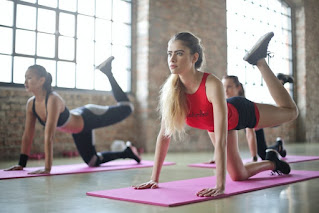WHAT IS EXERCISE?
 |
| Image source - pixabay | Image by - Shutterstock |
Exercise is a planned, structured and repetitive physical activity in order to condition any part of the body. Exercise is used to improve health, maintain physical fitness, and is important as a means of physical rehabilitation. It is an important part of maintain physical and mental health.
Whether people exercise lightly, such as going for a walk or high-intensity activities, for example, cycling uphill or weight training, regular exercise provides a wide range of benefits for the body and mind.
Taking part in exercise of any intensity every day is essential to prevent a variety of illnesses and other health problems.
In this article, we explain the different types of exercise and their benefits, as well as the considerations for designing an exercise regimen.
What are the three types of exercise?
Most people tend to focus on one type of exercise or activity and think they are doing enough. Research has shown that it is important to do all three types of exercise:
aerobic
anaerobic
agility training
These three types are explained below.
Aerobic exercise
 |
| Image source - unsplash | Image by - Bruce Mars |
Simply put, aerobic exercise is also known as cardiovascular exercise. This is because it works with your cardiovascular system, that is to be your heart and light. Cardiovascular or aerobic exercise involves sustained activity that causes your heart and respiratory rate to work at an accelerated rate for an extended period of time. Aerobic exercise also involves pumping oxygenated blood to the working muscles. This type of exercise includes things like spinning, biking, jogging, swimming, dancing, and other similar activities.
Aerobic exercise provides the following benefits:
- Enhances muscle strength in the lungs, heart, and entire body.
- Lowers blood pressure.
- It improves circulation and blood flow in the muscles.
- Increase red blood cell count to improve oxygen transport.
- Reduces the risk of diabetes, stroke and cardiovascular disease and improves life expectancy and symptoms for people with coronary artery diseases.
- Improves life expectancy and symptoms in people with coronary artery disease.
- It stimulates bone growth and reduces the risk of osteoporosis when it is at high intensity.
- Improve sleep hygiene.
- It improves endurance by increasing the body's ability to store energy molecules, such as fats and carbohydrates, within the muscle.
Anaerobic exercise
Image source - unsplash | Image by - John Arano
The word anaerobic literally means "without oxygen". Anaerobic exercise is a high intensity but short duration activity, where the body's oxygen demand is much greater than the available oxygen supply. This type of exercise depends on the energy sources that are stored in the muscles. Some types of anaerobic exercise include jumping rope, interval training, heavy weight lifting, all kinds of sprinting (cycling, running, etc.), climbing, swimming, isometry, or any quick burst of hard exercise. People use aerobic exercise to build power, strength, and muscle mass. These exercises are high intensity activities that should not last more than 2 minutes.
Anaerobic exercise provides the following benefits:
- Builds and maintains lean muscle mass.
- Protect your joints. Increasing muscle strength and muscle mass helps protect your joints, which can protect you from injury.
- Increases metabolism. Anaerobic exercise helps increase metabolism because it helps build and maintain lean muscle. Lean muscle mass is metabolically active, so you have the more lean muscle mass , the more calories you will burn.
- Increases strength and bone density.
- Anaerobic activity will increase bone strength and density more than any other type of exercise, therefore lowering the risk of osteoporosis.
- Improve your energy. Your body depends on the glycogen stored in your muscles for energy, regular anaerobic exercise increases your body's ability to store glycogen, giving you more energy during intense physical activity.
- Regular anaerobic exercise increases strength, speed, and power, which will ultimately help Increases our sports performance.
Agility training
 |
| Image source - pixabay | Image by - Shutterstock |
Agility training aims to developed a person’s ability to maintain control while speeding up, slowing down, and changing direction.
For example, in tennis, agility training helps a player maintain control over their court positioning through good recovery after each shot.
People who involved in sports that heavily rely on positioning, coordination, speed, and balance need to engage in agility training regularly.
The following sports are examples of ones that require agility:
tennis
American football
hockey
badminton
volleyball
basketball
soccer
martial arts
boxing
wrestling
Stretching and flexibility
Some exercises combine stretching, muscle conditioning, and balance training. A popular and effective example is yoga. Yoga movements improve flexibility, posture, and circulation. The practice originated in Nepal thousands of years ago and aims to unify the mind, body and spirit. Nowadays yoga uses a combination of meditation, posture, and breathing exercises to achieve the same goals.
A yoga practitioner can tailor a course to individual needs. A person looking to control arthritis may need gentle stretching to improve mobility and function. Someone with depression, on the other hand, may need more emphasis on the elements of relaxation and deep breathing of yoga. Pilates is another stretching option that upgradea flexibility and core strength. Tai Chi is also an effective exercise option that promotes calm stretching instead of intensity. It can also contribute to an increased risk of premature death from all causes, including complications from overweight and obesity. In many parts of the world, including the United States, the number of people who are overweight and obese continues to rise rapidly.
How can we exercise on a busy schedule?
Adjusting exercise to a busy schedule can be an obstacle to a successful regimen. However, people don't need to spend large amounts of extra time exercising to see the benefits.
Here are some tips for adapting physical activity on a busy schedule:
- See what car trips you can replace with walking or biking. Do I need to drive to work? If so, try to park half a mile away from the office and walk the last stretch.
- People who commute to work on public transportation might try to get off their bus or train a few stops early and walk the rest of the way.
- Consider going up and down the stairs in your office instead of taking elevators or escalators.
- Try to think about the amount of time you spend watching television and avoid television programs. While watching television for long periods, light exercises, such as stomach crunches or jumps, can help a person include more physical activity in their day.
- If a person enjoys video games, they might consider playing games that encourage physical activity, such as exercise routines on a Nintendo Wii.
- Vigorous housework, gardening, and going up and down stairs while doing chores also qualify as physical activity and can help people productively meet the guidelines.
People are likely to get the most benefit from the exercises they enjoy that fit their lifestyle. Some of the examples below are the easiest to fit into a daily routine:
- Take a quick 30-minute walk five times a week.
- Walk your dog more often or go for a walk and jog with friends.
- Try adding swimming to your weekly routine, even if it's not every day.
- Start some exercise classes that are fun, collaborative, and educational and become a member of a martial arts club. Beginner sessions can be smooth and fun.
Exercise is sometimes a gradual learning curve. A person should extend the sessions during the week and increase the intensity slowly. It is important for people to make sure they drink plenty of water during and after exercise. Consulting with a doctor is a good precaution if someone has a health condition or injury that could affect exercise levels, or if exercise could worsen. The combination of aerobic and anaerobic exercise provides the most benefit, any exercise is better than none for people who currently have an inactive lifestyle.
Tips to get started
Exercise can be difficult to maintain for some people. Consider the following tips for long-term success:
1. Have a clear goal:
Whether for health or other reasons, try to always keep in mind the reason why you started increasing your exercise levels.
2. Work at your own pace:
Doing too much and too quickly can increase the risk of injury and the possibility of developing a stable routine. Set goals based on the goals you set at the beginning of the regimen and celebrate small gains to build confidence.
3.Enjoy:
A regime is more sustainable if a person enjoys the physical activities that it implies.
4. Join a club with a friend:
If you join a gym with a friend or exercise with a friend, you can enjoy more of the sessions. Some people prefer not to have someone else's stress nearby. This depends on you.
5. Trainers and teachers can be helpful: People who are just starting a regimen or looking to intensify their routine can benefit from a personal trainer or teacher. They can provide motivation and guidance, helping people to follow their goals and stay dedicated.
6. Vary your exercises:
Change your exercise program every weeks. Mixing it can help a person work on different muscle groups and increase the range of benefits. If you enjoy a particular exercise like running, try changing the speed and distance of a race, or follow a different route with more hills.
7. Make it a habit:
After a few weeks of regularity, an exercise routine begins to become a habit, even if it's difficult or boring at first.
The benefits of regular physical activity are far-reaching and should be a part of every person's day to help them stay healthy.

Your Article is so awesome i want to say thank u from my whole team of www.acharesult.com and we are building our site like yours.
ReplyDeleteif you have any quires feel free mail us we can discuss something new
https://acharesult.com/contact-us/
definitely going to try these exercises
ReplyDeletecheckout my blogs on health tips as well http://arbazkhanblogs.blogspot.com/2020/05/10-healthy-lifestyle-tips.html
To let them know they better make a move soon:
ReplyDeleteRingtone song lyrics
Post a Comment